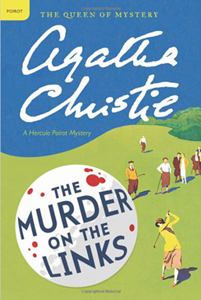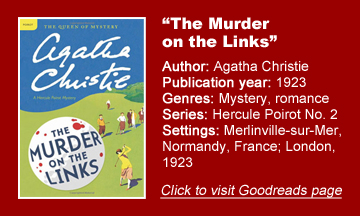“The Murder on the Links” (1923) might seem like the perfect Agatha Christie book to pair with a weekend in front of the TV watching the Masters, but the title is misleading. The murder happens on a golf course under construction, but it’s not committed with golf equipment, nor is there much talk of the sport – although Poirot notes that tee boxes (because they have order) are his favorite part of the game.
Everything except golf
That said, a robust inclusion of golf is about the only thing missing from this second Poirot novel, which includes rival detectives, forbidden love, dysfunctional families, and faked identities that stretch into complex backstories. Like many 1920s Christie books, it’s overstuffed. I enjoyed it, but I wouldn’t be surprised if Christie said after this one “I need to streamline my novels a bit.”
In “Murder on the Links,” we get a direct comparison of the methods of Poirot and French detective Giraud, who is like a hound, literally on his hands and knees at a crime scene. Christie leaves us with no doubt that Giraud’s methods – which seem so detailed and smart at first blush – have led to wrongful convictions.
He’s prone to locking on to the wrong path and embracing incidental or planted evidence while ignoring evidence that doesn’t fit his theory. To me, this is no joke; I think mistakes that cost people their lives or liberties should be a serious offense, not merely a treated like a misstep on the job. But I’ve always been in the minority there.
The number of French police working this case is so large that it’s difficult to keep them all straight – although, aside from the idiosyncratic Giraud, for the sake of reading comprehension it doesn’t matter that Hautet, Bex and Marchaud blend together in this case set at a pair of villas near Merlinville. I think Christie is going for a realistic portrayal of the French police system.
Without using the term, Poirot employs Occam’s razor, impressing upon Hastings – too credulous of Giraud’s skills – that the simplest answer is usually the correct one. It’s a good rule of thumb especially for this complex case that has more false endings than the 1985 mystery-comedy “Clue.”
Scene-stealing Cinderella
“Links” is a core novel in the timeline, as it’s where Hastings meets his wife, Cinderella. She will be so ignored in later books – with Hastings leaving her on the other side of the globe in Argentina while he tags along with Poirot – that one would wonder if she’s even real (especially considering her name) if not for this book.
In “The Mysterious Affair at Styles,” Hastings is politely rejected by two women, so perhaps Christie thought it was enough that he be Poirot’s intellectual punching bag and not also be perpetually heartbroken. After “Links,” we still get plenty of moments of Hastings being smitten by a beautiful face, but we are spared continual rejections since he’s a devoted married man.

It’s too bad Cinderella won’t be used more in later novels, because I like her acrobatic abilities and knack for thinking on the fly. And I’d like to see more of how and why she and Hastings click. I mean, Hastings at one point mistakes someone else for Cinderella, so I wouldn’t call their bond fully formed just yet. I guess when Christie wants to do “couples solve crimes,” she has Tommy and Tuppence, not to mention various pairings in standalone novels.
Fragile women
Women play substantial roles in “Links,” but interestingly, other than Cinderella, Christie portrays them as fundamentally fragile. The author resorts to one decidedly forced moment that almost had me snorting. The recently widowed-via-murder Mrs. Renauld faints and strikes her head, and the doctor immediately announces she’ll be unconscious for a week but otherwise she’ll be fine. Indeed, that’s exactly what happens, precisely serving the story’s needs.
Also mildly irksome, the detectives agree that the digging of a grave on the golf course is a man’s work. Under the Occam’s razor approach (it’s most likely that a man dug the grave, so therefore the detectives should pursue that course), this is fair enough. But it’s nonetheless funny that Christie suggests digging a hole in soft dirt is beyond a woman’s capabilities even if the task is essential in a premeditated murder.
“Murder on the Links” flirts with spiraling into over-complexity, hitting some threads into the woods, but Christie scrambles to save par. Almost every quirk of story and character behavior is accounted for, and the solution makes sense. But you’ll want to take a break at the 19th Hole after this satisfying yet exhausting round with Poirot and Hastings.
Every week, Sleuthing Sunday reviews an Agatha Christie book or adaptation. Click here to visit our Agatha Christie Zone.


